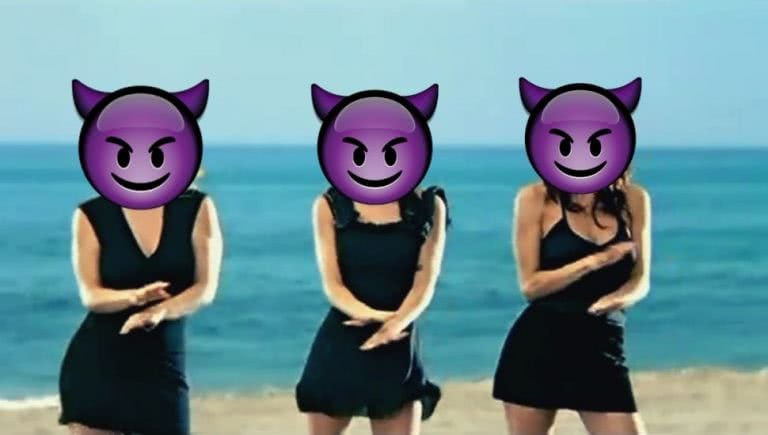Remember when innocent girl band Las Ketchup was tied up in an endlessly unravelling saga of religious entities claiming that their bop ‘The Ketchup Song (Aserejé)’ is, in fact, a satanic hymn to the dark lord? Well, just in case you forgot, I’m here to remind you.
‘The Ketchup Song (Aserejé)’ was the stunning debut single by Spanish pop group Las Ketchup, taken from their debut studio album Hijas del Tomate (2002). The band seemed primed and ready to be one-hit-wonders, with all their tomato themed imagery lining up perfectly. The song was released on 10 June 2002, and became an international hit later that year.
In addition to the original Spanish version, the song exists in forms with Spanglish and Portuguese verses, although the nonsensical chorus is identical in all three versions. Nonsensical… or satanic.
To the common ear, the song tells the story of a travelling man with mystical qualities, which heavily references ‘Rapper’s Delight’. However, after its release, the song became controversial due to conspiracy theories that the lyrics were cryptic references to Satanism, the devil, Hell, and a whole smorgasbord of other excitingly evil things.
Forget Charmed, my new favourite devilish witch trio are the Las Ketchup girls.
So as the ancient tomes say, this is the breakdown as to why the song is perceived as a satanic dance bop. The ancient tomes being Google Translate of course. For this analysis, we will be looking at the Spanish version of the song translated to English by Google. All other versions are deceptive and full of lies.
Love Music?
Get your daily dose of metal, rock, indie, pop, and everything else in between.

Some say if you break down the word Aserejé you get the translation of “heretic being.”
The “A” means “one”, and the “ereje” means “heretic”, so essentially, some say the song is wickedly titled ‘The Ketchup Song (Heretic One’, which personally sounds like a party on the ninth floor of hell that we’d love to attend.
The first paragraph of the song begins as follows; “Look what’s coming, just around the corner comes Diego Rumbeando…”
Now who exactly is this Diego Rumbeando and what does he want with our Pope?
Critics don’t say much about this name except for that he may just be some messenger of evil, where the lines that follow reveal his true intent to bring damnation upon the mustard and BBQ sauce loving world.
“With the Moon in the pupils and his seawater suit, it seems contraband”.
Okay, so the dude only shows up at night. Not a coincidence at all. And his seawater suit implies he is wearing blue, which is allegedly the devil’s favourite colour. What’s warmer than blue after all. And don’t get me started on the contraband. Illegality is the weapon of Hell’s worst demons.

The strongest, most devilish lines of the song, according to the particular interpretation of religious believers, comes in the second paragraph of the much played song, which says:
“And where else does not fit a soul there he goes to cane (pleasure) possessed by the ragatanga rhythm.”
Clearly a reference to the fiery pits of Hell, where Diego is clearly from. We’ve all been doing hand-moves on P&O cruises that could have very well cursed us to our hellish ends. Really makes you think.

“And the DJ who knows playing the anthem of the twelve (time when the acts and satanic sacrifices are made) to Diego the most desired song, and dance, and enjoys and sings…”
Man loves a midnight sacrifice, so what? Could very well mean a Midnight snack. We’ve all been there. I mean, if that’s what they were trying to say, pitchfork my behind and call me Lucifer y’know.
And then the song goes on to mention Witchcraft and other joyous sins we try in our bedrooms.

The reason the song is so catchy? Because it implements the same sound of ‘Rapper’s Delight’, in order to achieve mass popularity and blind the youth into being blindly submissive to their tomato overlords in Hell.
That, or the song is just a feel-good hit of the Summer that will never grow old… unless… haha just kidding… unless…


































